Sun protection is as important to boaters as securing a life jacket. We slap on sunscreen with an SPF (sun protection factor) of 15 or greater. Or, increasingly, we are encouraged to cover our skin. But does every fabric offer the same protection? We did some rudimentary tests to verify the UPF — ultraviolet protection factor — rating for a collection of popular outdoor garments.
UPF Technology: All fabrics block UV light. Some do it better than others. You’ve noticed UPF 50 or UPF 30 labels on outdoor wear. But what do they mean?
UPF ratings are determined by measuring the amount of UV light transmitted through a fabric. The test standards were first set by Australian scientists and adopted by the American Society of Testing and Materials. Our tests are not as sophisticated as ASTM’s, but they provide a valid comparison and ratings confirmation between various UPF-rated garments. They make you better equipped to make boating in the sun safer and more fun.
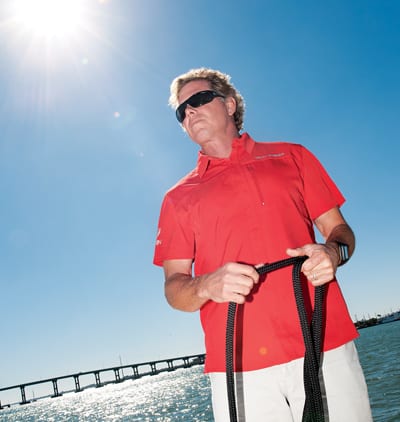
How We Tested — Myths We Busted
What we tested: We tested 10 UPF-rated garments and five unrated garments. We tested the unrated garments to challenge an urban legend we’d heard: Natural fabrics don’t make good UV barriers.
How We Tested: 1. BoatingLAB used an industrial UV sensor normally employed to measure UV light used to cure resins in molding processes. 2. Our UV light source was a simple black light. 3. We used a spacer to maintain exact distance between the UV light, fabric and sensor each time.
Results: Our test procedures were crude by ASTM standards but furnished relative results that showed consistency between the manufacturer UPF rating and UV protection we recorded. With such small percentage differences between the established ratings, and no way to measure margin of error, we can’t confirm or dispute the absolute number of any UPF rating. Our results show how various garments performed in our test regimen.
Myth Busted: Synthetics are Better at Blocking UV
Tightly woven cotton blocked as much UV as synthetics.
Myth Busted: Wet Fabrics Lose UV Protection
We found extremely minor and nearly unmeasurable differences between wet- and dry-fabric UV transmission.
Myth Busted: Fabric Coatings are Required
Some manufacturers, like Simms, attribute UV blocking to a coating. Sun Guard laundry additive worked too. But fabric density was just as important in many products tested.
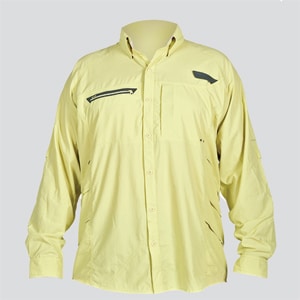
Columbia
Airgill Chill
Design: Columbia relies on the UV resistance of nylon and the tight weave of the fabric to reflect and absorb UV rays. Omni-Freeze technology is reported to lower fabric temperature when in contact with sweat. To enhance comfortable feel, Columbia has incorporated “air gill” vents that allow air to enter the garment and circulate out the back vents.
Microscopic: Nylon is inherently UV filtering, and this product’s filtration is aided by a tight denier or weave.
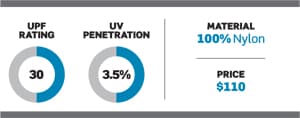
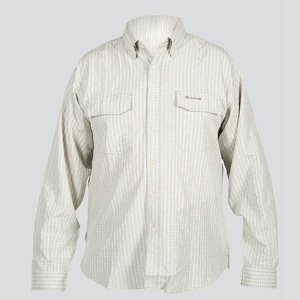
Simms
Bug Blocker
Design: This cool, breathable fabric dries quickly, thanks to wicking properties of the fibers. The comfortable, light, breathable fabric is fortified with Simms COR3 coating that has antimicrobial factors, repels bugs and enhances its UPF rating. Like the Airgill, it has long sleeves, which can be buttoned up for a short-sleeve look. It makes a great sports shirt on shore.
Microscopic: The fabric is light and light-colored, but a tight weave and UV-absorbing treatment keep its UPF high.
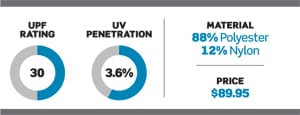
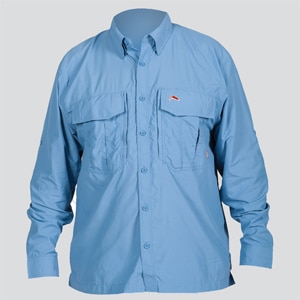
Simms
Guide Shirt
Design: This cape-back shirt has bellows pockets and secure, hidden zippered pockets. The square-cut tail is plenty long for tucking and staying. Nylon fabric is quick to dry, making handwashing for next-day wear practical.
Microscopic: The tight weave allows little UV penetration, and the darker color absorbs UV light as well. UV protection comes from the nylon weave and will last as long as the fabric.
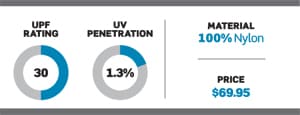
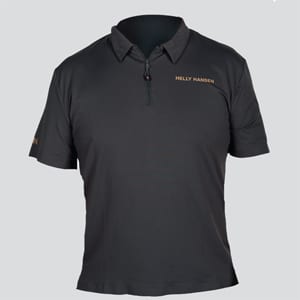
Helly
Odin Series Polo
Design: The black polyamide fabric was nearly impenetrable, stopping nearly 97 percent of all light and, in our test, 99.35 percent of UV light, living up to its 50-plus UPF rating. It has the soft feel of microfiber and wicks quickly, feeling cool to the skin. Zippered collar is retro, as is the snug fit. Buy a size larger for a looser fit.
Microscopic: A looser weave allows some UV penetration, but dark colors absorb more UV light, balancing the act.
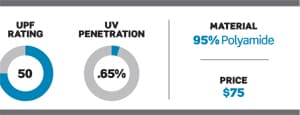
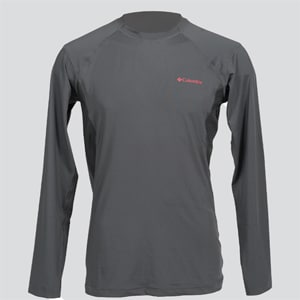
Columbia
Sun Guard Long Sleeve
Design: We think the simple tee construction makes for added comfort and easy care. Columbia’s Omni-Wick design is fast-drying and aided by ventilated mesh sides and underarms. The form-fitting shirt can double as a rash guard or “go under” in cooler weather as a base layer.
Microscopic: UV-absorbing black dye and a tight weave give this shirt a high protection factor.
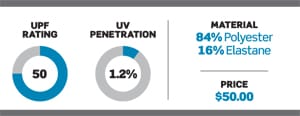
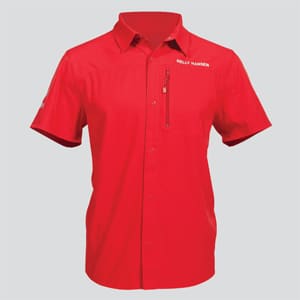
Helly
Odin Series S/S
Design: A soft microfiber texture gives this garment a cool, comfortable feeling when worn. It wicks quickly. Its dense weave gives superior sun protection. True to size, this sporty shirt offers protection to the torso and shoulders and the comfort of short sleeves. Snap closures are ideal for boating. Buy a size larger for added freedom of movement.
Microscopic: Dark dyes like red or black plus this tight weave allowed the shirt to test above its UPF grade.
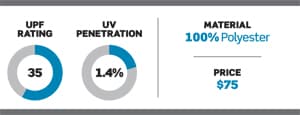
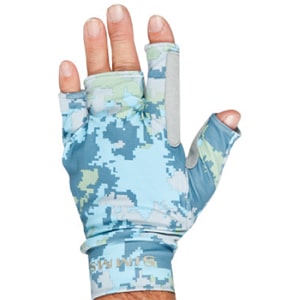
SunGloves
Get a grip with these handy sun protectors.
UPF: 50
Material: 92 percent polyester, 8 percent Spandex
Price: $29.95
Design: SunGloves came and went in the ’90s due to poor performance. These sport “grippy” finger pads and open palms, putting sun protection just where you need it.
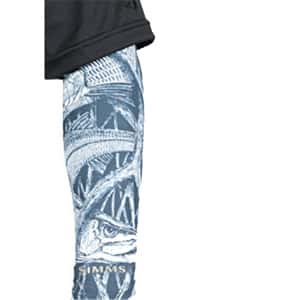
SunSleeves
Fit is like a tattoo; it protects like a long sleeve.
UPF: 50
Material: 92 percent polyester, 8 percent Spandex
Price: $34.95
Design: Spandex-empowered sleeves are snug and cool and keep you cool, while affording sun protection that doesn’t require reapplication. Camo patterns available.

How Do Garments Not Rated UPF Compare?
Unrated Fabric Test Notes: We tested ordinary T-shirts and dress shirts to see how their UV protection qualities fared.
How We Did It: We took readings with our UV meter through the fabric at a fixed distance from a black light. The rest is simple math. UV light through fabric ÷ total UV light = percentage of UV light transmission (penetration).
Myth Busted: Only UPF-Rated Fabrics Block UV Light
Not so fast. We did find unrated fabrics that didn’t reach 30 UPF and some that reached 50-plus UPF. One reading we found still reached UPF 15. Only one test garment failed to meet the minimum rating of UPF 15.
Myth Busted: You Need UPF Fabrics to be Safe
UPF-rated fabrics offer the assurance of a specific level of protection for boaters unwilling to risk an assumption.
Summary: Unrated fabrics we tested provided excellent UV protection. Throughout the tests, darker colors normally attained higher UPF ratings than lighter colors. Tighter or thicker weaves rated higher than thinner, looser weaves. While we would be confident wearing a heavier weight cotton tee, UV-rated tech shirts can offer superior protection.
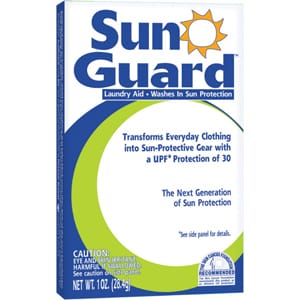
Sun Guard: Sun Protection You Wash In
Test Notes: In the course of our research, we stumbled upon Sun Guard, hyped as increasing a fabric’s UPF factor by 30. It contains the UV blocker Ciba Tinosorb FD. The product directions called for sprinkling the powder into a flooded washer. In our front-loading washer, we applied the packet in a quart of water, which may have affected our still-impressive results. We also washed several low-scoring polyester knit T-shirts in it to see if we could improve their lot — and we did, dramatically doubling the protective capabilities of some fabrics.

UPF Facts
UPF: The ultraviolet protection factor rating is used only on fabric.
SPF: The sun protection factor rating is used only on sunscreen products.
UPF 30: This means 1/30 of available UV light penetrates a fabric. UPF 50 allows 1/50 to penetrate.
SPF 30: This means that, if unprotected skin burns with 10 minutes of sunlight, protected skin will take 300 minutes to burn.
UV Light: UV light is electromagnetic radiation and is invisible to the human eye, though some animals are believed to be able to see it.
UVA: It does not cause sunburn but contributes to aging and skin cancer.
UVB: It causes sunburn and damages DNA molecules, resulting in skin cancer.








